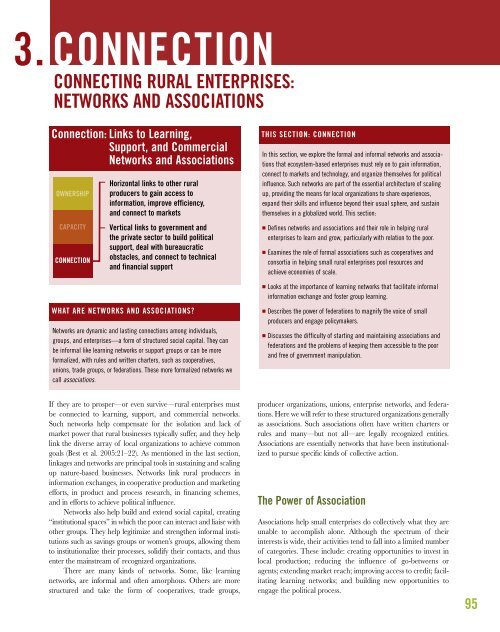Growing the Wealth of the Poor - World Resources Institute
Growing the Wealth of the Poor - World Resources Institute
Growing the Wealth of the Poor - World Resources Institute
You also want an ePaper? Increase the reach of your titles
YUMPU automatically turns print PDFs into web optimized ePapers that Google loves.
3. CONNECTIONCONNECTING RURAL ENTERPRISES:NETWORKS AND ASSOCIATIONSConnection: Links to Learning,Support, and CommercialNetworks and AssociationsOWNERSHIPCAPACITYCONNECTIONHorizontal links to o<strong>the</strong>r ruralproducers to gain access toinformation, improve efficiency,and connect to marketsVertical links to government and<strong>the</strong> private sector to build politicalsupport, deal with bureaucraticobstacles, and connect to technicaland financial supportTHIS SECTION: CONNECTIONIn this section, we explore <strong>the</strong> formal and informal networks and associationsthat ecosystem-based enterprises must rely on to gain information,connect to markets and technology, and organize <strong>the</strong>mselves for politicalinfluence. Such networks are part <strong>of</strong> <strong>the</strong> essential architecture <strong>of</strong> scalingup, providing <strong>the</strong> means for local organizations to share experiences,expand <strong>the</strong>ir skills and influence beyond <strong>the</strong>ir usual sphere, and sustain<strong>the</strong>mselves in a globalized world. This section:■ Defines networks and associations and <strong>the</strong>ir role in helping ruralenterprises to learn and grow, particularly with relation to <strong>the</strong> poor.■ Examines <strong>the</strong> role <strong>of</strong> formal associations such as cooperatives andconsortia in helping small rural enterprises pool resources andachieve economies <strong>of</strong> scale.CAPACITY■ Looks at <strong>the</strong> importance <strong>of</strong> learning networks that facilitate informalinformation exchange and foster group learning.WHAT ARE NETWORKS AND ASSOCIATIONS?Networks are dynamic and lasting connections among individuals,groups, and enterprises—a form <strong>of</strong> structured social capital. They canbe informal like learning networks or support groups or can be moreformalized, with rules and written charters, such as cooperatives,unions, trade groups, or federations. These more formalized networks wecall associations.■ Describes <strong>the</strong> power <strong>of</strong> federations to magnify <strong>the</strong> voice <strong>of</strong> smallproducers and engage policymakers.■ Discusses <strong>the</strong> difficulty <strong>of</strong> starting and maintaining associations andfederations and <strong>the</strong> problems <strong>of</strong> keeping <strong>the</strong>m accessible to <strong>the</strong> poorand free <strong>of</strong> government manipulation.If <strong>the</strong>y are to prosper—or even survive—rural enterprises mustbe connected to learning, support, and commercial networks.Such networks help compensate for <strong>the</strong> isolation and lack <strong>of</strong>market power that rural businesses typically suffer, and <strong>the</strong>y helplink <strong>the</strong> diverse array <strong>of</strong> local organizations to achieve commongoals (Best et al. 2005:21–22). As mentioned in <strong>the</strong> last section,linkages and networks are principal tools in sustaining and scalingup nature-based businesses. Networks link rural producers ininformation exchanges, in cooperative production and marketingefforts, in product and process research, in financing schemes,and in efforts to achieve political influence.Networks also help build and extend social capital, creating“institutional spaces” in which <strong>the</strong> poor can interact and liaise witho<strong>the</strong>r groups. They help legitimize and streng<strong>the</strong>n informal institutionssuch as savings groups or women’s groups, allowing <strong>the</strong>mto institutionalize <strong>the</strong>ir processes, solidify <strong>the</strong>ir contacts, and thusenter <strong>the</strong> mainstream <strong>of</strong> recognized organizations.There are many kinds <strong>of</strong> networks. Some, like learningnetworks, are informal and <strong>of</strong>ten amorphous. O<strong>the</strong>rs are morestructured and take <strong>the</strong> form <strong>of</strong> cooperatives, trade groups,producer organizations, unions, enterprise networks, and federations.Here we will refer to <strong>the</strong>se structured organizations generallyas associations. Such associations <strong>of</strong>ten have written charters orrules and many—but not all—are legally recognized entities.Associations are essentially networks that have been institutionalizedto pursue specific kinds <strong>of</strong> collective action.The Power <strong>of</strong> AssociationAssociations help small enterprises do collectively what <strong>the</strong>y areunable to accomplish alone. Although <strong>the</strong> spectrum <strong>of</strong> <strong>the</strong>irinterests is wide, <strong>the</strong>ir activities tend to fall into a limited number<strong>of</strong> categories. These include: creating opportunities to invest inlocal production; reducing <strong>the</strong> influence <strong>of</strong> go-betweens oragents; extending market reach; improving access to credit; facilitatinglearning networks; and building new opportunities toengage <strong>the</strong> political process.95
















